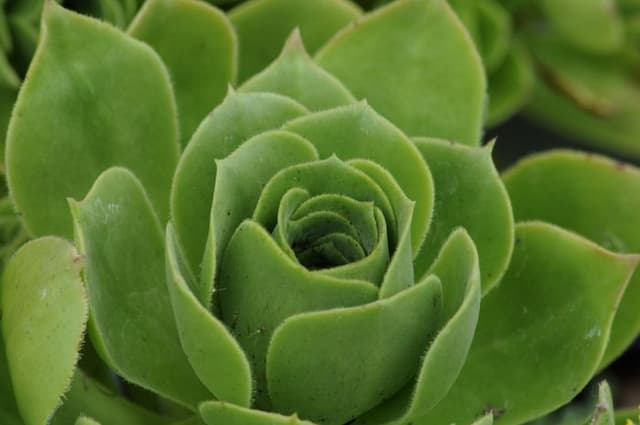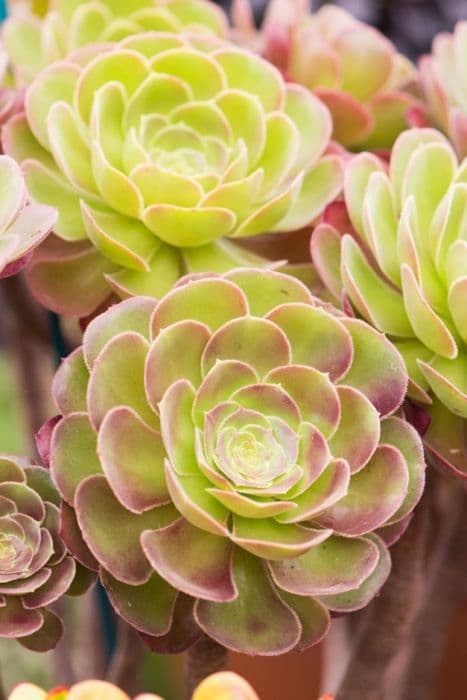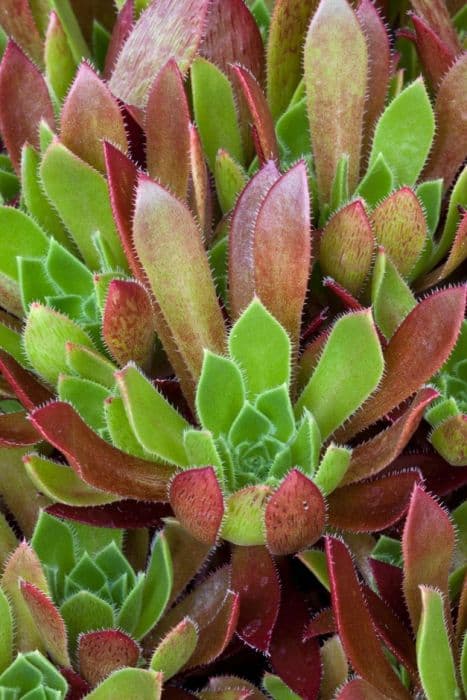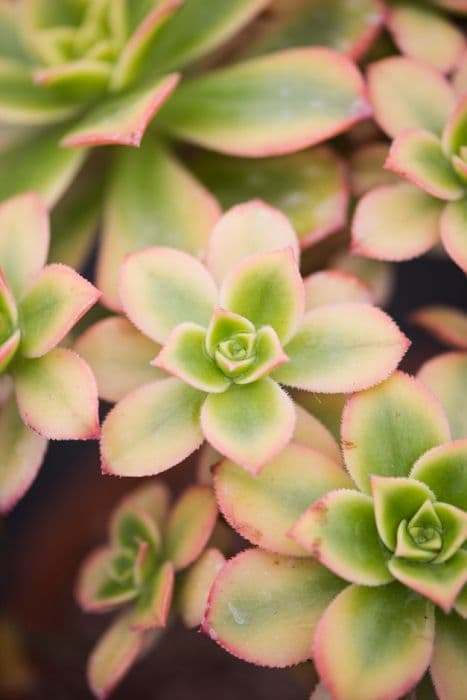Stonecrop Hylotelephium 'Class Act' (PBR)

ABOUT
Hylotelephium 'Class Act', often known as Stonecrop, is a striking perennial plant known for its attractive foliage and showy blooms. It’s a hardy succulent that boasts thick, fleshy leaves which often have a waxy or dusty coating and may display shades of blue-green, often with a hint of purple or pink, especially as the weather cools. Come late summer to early fall, Stonecrop 'Class Act' shines with clusters of star-shaped flowers. These flowers are densely packed together in broad, flat-topped flower heads, which add an alluring visual contrast to the succulent leaves. They typically exhibit a strong, vibrant pink hue that can become more intense over time. The flowers are an excellent attractor for pollinators such as bees and butterflies, while after blooming, the seed heads provide interest into the winter months if left untrimmed. With its lush foliage and exuberant floral display, Stonecrop 'Class Act' is a lovely addition to rock gardens, borders, or as a ground cover in suitable climates. Its resilience and low maintenance needs make it a favored choice for gardeners looking to add enduring and attractive elements to their landscapes.
About this plant
 Names
NamesFamily
Crassulaceae
Synonyms
Stonecrop, Sedum
Common names
Sedum 'Class Act', Hylotelephium telephium 'Class Act', Hylotelephium spectabile 'Class Act'
 Toxicity
ToxicityTo humans
Stonecrop, commonly referred to as Sedum, is generally considered to be non-toxic to humans. However, it should be noted that ingesting any plant material might cause some mild gastrointestinal discomfort due to the presence of saponins and other compounds. Although serious poisoning is rare, symptoms of ingesting significant amounts of Sedum may include nausea, vomiting, or diarrhea. It's always a good practice to avoid eating any parts of ornamental plants due to the potential for adverse reactions.
To pets
Stonecrop or Sedum is not known to be highly toxic to pets. However, ingesting this plant can potentially cause mild gastrointestinal upset in some animals. Symptoms of ingestion might include vomiting, diarrhea, or drooling. While the plant is not expected to cause severe poisoning, it's advisable to prevent pets from consuming it and to seek veterinary advice if you suspect your pet has eaten a large amount of any non-food plant.
 Characteristics
CharacteristicsLife cycle
Perennials
Foliage type
Deciduous
Color of leaves
Green
Flower color
Pink
Height
1-2 feet (30-60 cm)
Spread
1-2 feet (30-60 cm)
Plant type
Succulent
Hardiness zones
3-9
Native area
Asia
Benefits
 General Benefits
General Benefits- Easy to grow - Known for its low maintenance requirements and adaptability to a range of soil types.
- Drought tolerant - Once established, it requires minimal watering, making it an excellent choice for water-wise gardening.
- Attracts pollinators - Flowers are attractive to bees, butterflies, and other beneficial pollinators, enhancing biodiversity.
- Long blooming season - Provides color in the garden from late summer into fall when other plants may have finished blooming.
- Winter interest - The dried flower heads provide visual interest during the winter months.
- Suitable for containers - Its compact size makes it a good choice for pots and container gardening.
- Deer resistant - Generally not preferred by deer, which can help reduce garden damage in areas where deer browsing is a problem.
 Medical Properties
Medical PropertiesThis plant is not used for medical purposes.
 Air-purifying Qualities
Air-purifying QualitiesThis plant is not specifically known for air purifying qualities.
 Other Uses
Other Uses- Craft Projects: Sedum 'Class Act' can be used in dried floral arrangements or wreaths due to its sturdy stems and lasting flowers, adding a unique texture and color to crafts.
- Garden Photography: The striking blooms and structure of Sedum 'Class Act' make it a popular subject for garden photographers looking to capture the beauty of different plant species.
- Soil Erosion Control: Due to its robust root system, Sedum 'Class Act' can be used in garden spots prone to erosion, helping to hold the soil in place.
- Green Roofing: With its drought tolerance, Sedum 'Class Act' is often chosen for planting on green roofs, contributing to building insulation and reducing run-off.
- Educational Tool: Sedum 'Class Act' is an example of a drought-resistant plant and can be used in educational settings to demonstrate xeriscaping and water-wise gardening techniques.
- Garden Art: The unique form of Sedum 'Class Act' allows it to be used in garden art, where its clusters of pink flowers can be a living element of the design.
- Bee and Butterfly Gardens: Sedum 'Class Act' is an excellent nectar source and can be used to attract pollinators like bees and butterflies to the garden, contributing to their conservation.
- Living Fences: When planted in a row, Sedum 'Class Act' can create a low, living barrier or edging in the garden, providing a more natural alternative to hardscaping.
- Seasonal Decoration: The flower heads of Sedum 'Class Act' can be cut and used in fall decorations, offering an autumnal color and texture to displays.
- Model Landscaping: Miniature gardeners and model railroad enthusiasts can use Sedum 'Class Act' in their tiny landscapes due to its small size and interesting foliage.
Interesting Facts
 Feng Shui
Feng ShuiThe Sedum 'Class Act' is not used in Feng Shui practice.
 Zodiac Sign Compitability
Zodiac Sign CompitabilityThe Sedum 'Class Act' is not used in astrology practice.
 Plant Symbolism
Plant Symbolism- Resilience: As a succulent, the 'Class Act' stonecrop (the most common common name for Hylotelephium 'Class Act' (PBR)) symbolizes the ability to withstand harsh conditions and represents strength and the capacity to overcome adversity.
- Survival: Given its drought-resistant nature, this stonecrop reflects an incredible survival instinct and is often associated with the perseverance needed to make it through tough times.
- Longevity: Succulents are renowned for their long lifespans, which can symbolize enduring love, eternal life, or long-lasting friendship, depending on the context.
- Peace: The 'Class Act' stonecrop may also represent tranquility and calm, given its ease of care and the serene feeling many succulents can bring to a space.
 Water
WaterStonecrop 'Class Act' requires moderate watering, allowing the soil to dry out between waterings. Water approximately once a week with 1 gallon of water per plant during the active growing season, in spring and summer. In the winter, reduce watering to every other week or less, depending on temperature and humidity, as the plant is dormant and requires less moisture. Avoid waterlogging the soil, as Stonecrop is susceptible to root rot if kept too wet. It’s best to water deeply and less frequently to encourage a strong root system.
 Light
LightStonecrop 'Class Act' thrives in full sun conditions, requiring at least 6 hours of direct sunlight daily. The ideal spot for Stonecrop is an area that is exposed to unobstructed sunlight for most of the day. If grown indoors, place near a south-facing window to ensure it receives enough light. While it can tolerate some partial shade, too little light can lead to weak growth and fewer blooms.
 Temperature
TemperatureStonecrop 'Class Act' is hardy, withstanding temperatures down to around 20 degrees Fahrenheit and thriving in temperatures up to 90 degrees Fahrenheit. The ideal temperature range for optimal growth is between 65 and 75 degrees Fahrenheit. Avoid exposing Stonecrop to temperatures below 20 degrees Fahrenheit for prolonged periods, as this can cause damage or kill the plant.
 Pruning
PruningPruning Stonecrop 'Class Act' can encourage a bushier growth habit and maintain plant health by removing dead or damaged stems. Prune in the early spring before new growth starts, cutting back up to one-third of the plant to stimulate fresh growth. Additionally, after blooming, you can deadhead the spent flowers to tidy up the plant and potentially encourage a second, although smaller, bloom period in the same season.
 Cleaning
CleaningAs needed
 Soil
SoilThe best soil mix for Autumn Joy, commonly known as Hylotelephium 'Class Act', is one that is well-draining, such as a mixture of potting soil, peat moss, and perlite or coarse sand. An ideal soil pH for Autumn Joy is slightly acidic to neutral, ranging from 6.0 to 7.5. Ensure the soil allows for proper drainage to prevent root rot.
 Repotting
RepottingAutumn Joy should be repotted every 2-3 years to prevent overcrowding and to refresh the soil. This timeframe can vary depending on the growth rate and the size of the container. When repotting, choose a container only slightly larger than the previous one to maintain a compact root system.
 Humidity & Misting
Humidity & MistingAutumn Joy thrives best in average room humidity conditions. It is a drought-tolerant plant that prefers drier air, making it suitable for typical home environments. There is no need to increase humidity around this succulent-like plant.
 Suitable locations
Suitable locationsIndoor
Place in bright light, low water, well-draining soil.
Outdoor
Full sun, well-draining soil, drought-tolerant.
Hardiness zone
3-9 USDA
 Life cycle
Life cycleHylotelephium 'Class Act', commonly known as Sedum 'Class Act', begins its life cycle as a seed that germinates in early spring, with optimal soil temperature and moisture levels being crucial for successful sprouting. Following germination, the seedling emerges and develops into a small plant with succulent leaves; this vegetative stage sees rapid growth as the plant establishes its root system. During the summer, the Sedum 'Class Act' enters a maturation phase where it forms tight clusters of star-shaped flowers, usually around late summer to fall, attracting pollinators and signaling its reproductive stage. After pollination, the plant produces seed heads that mature and release seeds, ensuring the next generation of plants. As temperatures decrease in the fall, the plant may die back, especially in colder climates, entering a period of dormancy through the winter months. In spring, new growth will often resume from the root system, or from any viable seeds that have overwintered and germinate when conditions become favorable.
 Propogation
PropogationPropogation time
Spring-Early Summer
Propogation: Hylotelephium 'Class Act', more commonly known as a type of Stonecrop, is generally propagated by cuttings. The best time for propagation is in the spring or early summer when the plant is actively growing. To propagate using cuttings, a 2-4 inch section of the stem should be cut using a sharp, clean tool. The cut end of the stem segment can be allowed to callous over for a couple of days before it is placed in well-draining soil. It's important to keep the soil moist but not waterlogged to encourage root development. Roots usually begin to form within a few weeks, at which point the new Stonecrop plant can gradually be acclimated to less frequent watering. This method encourages a high success rate and the creation of new plants that are true to the parent in form and characteristics.









